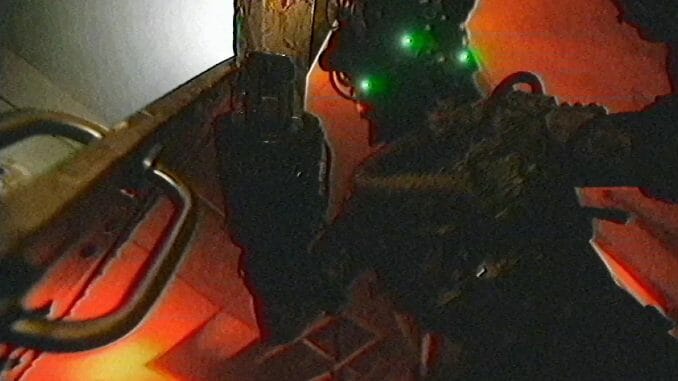V/H/S/94‘s Best Segment Asks What Would Happen If Someone Replaced Your Brain with a Camcorder

If you experienced any of the latter half of the 20th century, a significant portion of your memory inevitably includes analog video tape cassettes. Injected into the public psyche of that time by VHS technology were images of fizzing static, punctuations of sharp technicolor lines, muted colors, battery bars and timestamps. These idiosyncrasies have now become permanent emblems of collective nostalgia. The filmmakers involved in V/H/S/94, which exhibits a series of unrelated snuff-style short films uncovered in an FBI bust, are well aware of our societal connection to the tape cassette. The ambitious, thoughtful film emphasizes the personal nature of the medium to investigate just how close a camera can get to the experience of human consciousness.
V/H/S/94, the fourth installment in the beloved found footage anthology franchise, is the first in the series to really use its medium as its message. Part of what makes found footage such a popular filmmaking vehicle in the horror genre (Paranormal Activity, The Blair Witch Project, and Cloverfield just scratch the surface), is the fact that it’s usually presented as subjective, and therefore asks you to believe there is a real person behind the lens. This illusion manipulates the viewer into the belief that the horror being captured is somehow closer to them, whereas in a standard horror film the images feel more manufactured and there is a higher degree of separation between the grueling entity and the viewer. In a found footage film, we are also asked to believe that the camera cannot lie. The images in front of us are totally raw. This makes suspension of disbelief a considerably simpler task.
V/H/S/94 infiltrates our consciousness even further than most found footage horror films. In fact, it attempts to become consciousness. This inventive approach is employed, in particular, in the film’s third segment: “The Subject.” Directed by Timo Tjahjanto, the section is told via three cameras. One is manned by a retired-prosthetist-turned-mad-scientist (Budi Ross) as he documents his quest to successfully meld human and machine. Another is operated by a member of the SWAT team that eventually busts the scientist. But the most important is controlled by one of his medical subjects. However, she’s more than just a cameraperson. She is a literal camera-person: The apparatus replaces the top half of her head. Her new eyes are the lens; the camera microphone, her new ears.
In this case, the camera entirely becomes the subject. It overwhelms the senses: Her moans and attempts to cry out for help translate to the confused buzzing of a tape reel inside of a cassette. When the SWAT team breaks in and starts shooting at her, the battery bar runs lower with every blow. Her perspective also plays on a TV in the room, which reminds the audience that our role in a found footage horror movie is not unlike the scientist’s victim. We are asked to be both a viewer and an active participant, because this subgenre totally relies on our fear and our unique closeness to the subjects via the personal filmmaking style. But perhaps the most terrifying aspect of “The Subject” is that, because the camera is our protagonist, we discover the horrors of her new self alongside her in real time. When she enters a room and approaches a mirror, we hold our breath and brace ourselves for what she’s about to see. Suddenly, it is almost as if we are looking in the mirror and seeing ourselves as a grotesque human-robot hybrid.